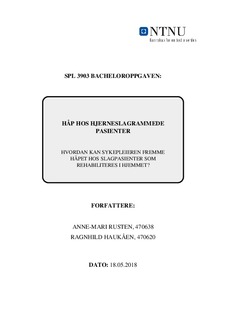| dc.contributor.advisor | Hamnes, Bente | |
| dc.contributor.author | Rusten, Anne-Mari | |
| dc.contributor.author | Haukåen, Ragnhild | |
| dc.date.accessioned | 2018-08-30T09:50:38Z | |
| dc.date.available | 2018-08-30T09:50:38Z | |
| dc.date.issued | 2018 | |
| dc.identifier.uri | http://hdl.handle.net/11250/2560012 | |
| dc.description.abstract | Bakgrunn: Sykepleieren møter pasienter i hjemmet og utgjør en viktig del av miljøet. Det er derfor viktig å ha kunnskap om hvilken innvirkning funksjonsnedsettelser har på pasientens håp. Håpet er betydningsfullt for slagpasienter i rehabiliteringsprosessen, og forutsetter at sykepleieren har kunnskap om håpets betydning, samt styrkende og svekkende faktorer. Rehabilitering i hjemmet er en svært godt dokumentert og effektiv metode når det gjelder slagpasienter. Samhandlingsreformen vektlegger å styrke kompetansen til helsepersonell i den kommunale helse- og omsorgstjenesten, slik at flere pasienter kan rehabiliteres i eget hjem. Hensikt: Å tilegne seg kunnskap om hvordan sykepleieren kan bidra til å fremme håpet hos slagpasienter som rehabiliteres i hjemmet, samt hvilke faktorer som påvirker det. Metode: Litteraturstudie. Et systematisk litteratursøk etter forskningsartikler ble gjort i databasen Cinahl. 8 kvalitative studier ble utvalgt og analysert. Resultat: Analysen av resultater presenteres i 4 hovedtemaer. 1) God relasjon mellom sykepleier og pasient, 2) Behovet for kunnskap og informasjon, 3) Bistå pasienten med å utvikle realistiske mål, og 4) Rehabilitering i hjemmet. Konklusjon: For å fremme håp er det viktig at sykepleier utvikler en god relasjon til- og ivaretar behovet for informasjon og kunnskap hos slagpasienter. Sykepleieren fremmer også håp ved å bidra til å utvikle realistiske mål, samt ved å tilrettelegge for rehabilitering i hjemmet. | nb_NO |
| dc.description.abstract | Background: The nurse approaches pasients at home and constitute an important part of the patient's environment. Hence, it is important to have the knowledge about what impact disabilities can cause on the patient's hope. Hope is important for stroke patients while undergoing rehabilitation, and presupposes that the nurse have knowledge about both the invigorating and debilitating factors regarding hope. Rehabilitation at home is well documented and is an effective method when it comes to stroke patients. The Healthcare Interaction Reform emphasizes to strengthen the competence of health professionals in the municipal healthcare service to make it possible for more patients to undergo rehabilitation at home. Purpose: To accumulate knowledge about how the nurse can contribute to promote hope in stroke patients undergoing rehabilitation at home, and which factors that affects hope. Method: Literature study. A systematic literature search for scientific research articles was performed in the Cinahl database. 8 qualitative studies were selected and analyzed. Results: The analysis of the results is presented in 4 main themes. 1) The importance of a good relationship between nurse and patient, 2) Need for knowledge and information, 3) Assist the patient in developing realistic goals, and 4) Home rehabilitation. Conclusion: To promote hope, it is important that the nurse develop a good relation to- and take care of the need for information and knowledge in stroke patients. The nurse also promotes hope by contributing to make feasible goals, and by facilitating for rehabilitation at home. | nb_NO |
| dc.language.iso | nob | nb_NO |
| dc.subject | sykepleie | nb_NO |
| dc.subject | hjerneslag | nb_NO |
| dc.subject | rehabilitering | nb_NO |
| dc.title | Håp hos hjerneslagrammede pasienter: Hvordan kan sykepleieren fremme håpet hos slagpasienter som rehabiliteres i hjemmet? | nb_NO |
| dc.title.alternative | Hope in pasients affected by stroke: How can the nurse promote hope in stroke patients who undergoes rehabilitation at home? | nb_NO |
| dc.type | Bachelor thesis | nb_NO |
| dc.subject.nsi | VDP::Medical disciplines: 700::Health sciences: 800::Nursing science: 808 | nb_NO |
| dc.source.pagenumber | 50 | nb_NO |
